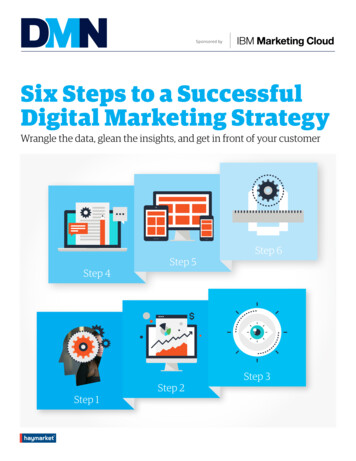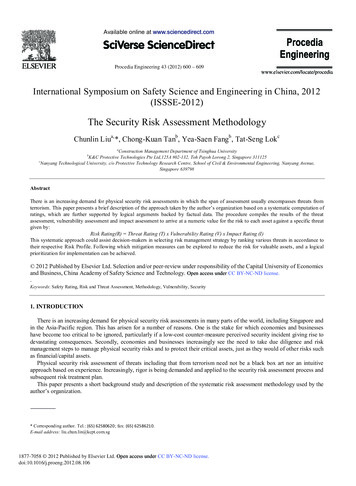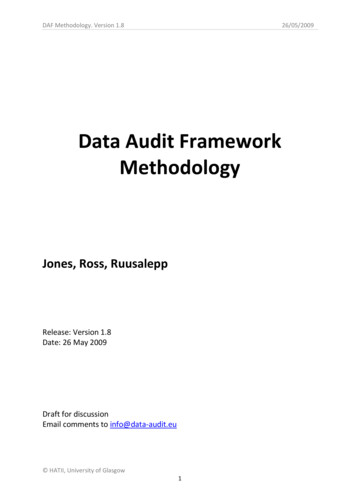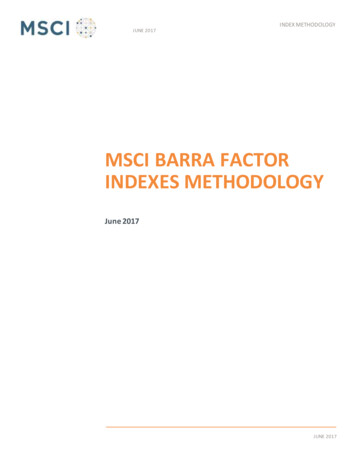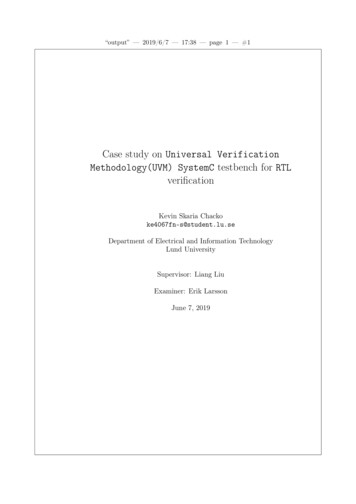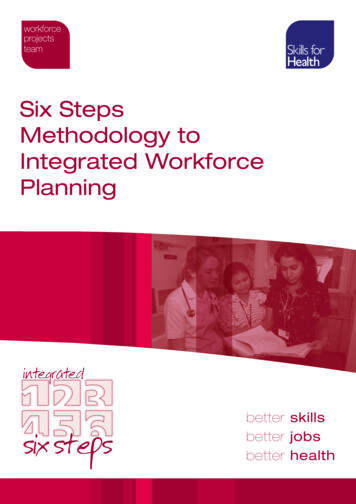
Transcription
Six StepsMethodology toIntegrated WorkforcePlanningintegrated
Six Steps Methodology to Integrated Workforce PlanningContentsForeword 2Introduction 3Generic Guide 4Step 1: Defining the Plan 6Step 2: Mapping Service Change 10Step 3: Defining the Required Workforce 18Step 4: Understanding Workforce Availability 24Step 5: Planning to Deliver the Required Workforce 30Step 6: Implement, Monitor and Refresh 36Six Steps Online 41Case Study 42
Skills for Health - Workforce Projects Team54 6231Developingan gservicechangeDefiningthe ng theplan1
Six Steps Methodology to Integrated Workforce PlanningForewordHigh Quality Care for All - NHS Next StageReview Final ReportThe Department of Health (DH) has unveiled its vision for the NHS of thefuture. It highlights the achievements of the past ten years, whilst theNext Stage Review sets out a vision for the future which consistentlydelivers the highest quality of care to all its patients, enabling staff tooffer treatments that are personal, effective and safe.There are workforce planning implications throughout the documentoutlining the systems for high quality education and training, clearroles and a locally led approach to workforce planning. Detailsinclude: Reform of workforce planning and education by devolvingdecision making to the front line with clear accountability Meet the needs of patients by developing the workforceHighNHSNextQuaEastofEast EnglandMidlandsLoNort ndonh EaSout North W stesth EasSout t CoasthCSout entralYorkshire West M h Westandithe H dlandsumberlity CStage Revieware FFinaor Al Reportllelements of the service plans The new system will require leadership and management ofworkforce planning and education commissioning based onstrong and constructive partnership with all professions New professional advisory bodies to contribute to strategic workforce development atall levels Independent advisory non departmental public body Medical Education England (MEE) toadvise DH on education and training of doctors, dentists, pharmacists and healthcare scientists Similar advisory bodies in each region Centre of Excellence to support national and local professional advisory bodies and widerhealthcare system Centre of Excellence to provide objective long term scanning, capability and capacitydevelopment for workforce planning functions and development of technical planningassumptions Replace historical funding arrangements of MPET with a tariff based system where fundingfollows the trainee.The full report is detailed at www.ournhs.nhs.uk.2
Skills for Health - Workforce Projects TeamThis methodology aims to support the Next Stage Review by providing a practical guide tosustainable and evidence based workforce planning. Six steps will be useful to anyone workingin healthcare human resources, workforce planning, service planning or in designing new waysof working. It helps managers take into account the local demographic situation, impact on otherservices and provides practical hints, tips and case studies to work through plans.Use of the guide across workforce planning will help ensure that decisions made around designand recruitment of new staff and teams are sustainable, realistic and fully support the delivery ofhigh quality patient care.Six Steps is supported by a range of resources aimed at increasing the capability of workforceplanners in the NHS, details include: UK Wide Workforce Planning Competence Framework Workforce Planning Competence Tool Workforce Planning Development Café.All available at www.healthcareworkforce.nhs.uk, and: Competence Application Tools Labour Market Information ResourceAvailable at www.skillsforhealth.org.uk.IntroductionAt its simplest, effective workforce planning ensures you will have a workforce of the right size, withthe right skills, organised in the right way, within the budget you can afford, delivering services toprovide the best possible patient care.Workforce plans are prepared at many levels. At a departmental level, there are the plans (staffingrotas) prepared once a month by a ward manager to ensure that their ward has all its shiftscovered by staff with the correct skills and competences to ensure that patient services aredelivered safely and effectively.At the most complex level, there are SHA level workforce plans which may be an aggregation of allthe plans submitted by the PCTs and by provider organisations which are used to support strategicand financial planning and education commissioning.You may need to plan your future workforce needs in the context of plans to reconfigure services.On the other hand, you may want to rethink the delivery of services in the context of an anticipatedshortage of staff with particular skills.The main aim of this six step guide is to set out in a practical framework those elements thatshould be in any workforce plan.It is important to be very clear why the plan is needed and for whom it is intended.Examples and case studiesAs an appendix to this guide, there is a case study to demonstrate how effective workforce plans,dovetailed with service and financial plans, have been developed and delivered using the Six Stepsmethodology.To help show how the steps may work out in specific service areas, a range of guides using the SixSteps methodology are available at www.healthcareworkforce.nhs.uk.3
Six Steps Methodology to Integrated Workforce PlanningGeneric GuideThe table below summarises the six generic workforce planning steps. The detailed sections thatfollow give more information on applying each of the steps.Six StepsBrief Narrative Key HeadingsIdentify why aworkforce planDefining the Planis needed andfor whom it isintended. PurposeStep 2 Goals / benefits ofStep 1Identify thepurpose andMapping Serviceshape of anyChangeproposedservice changethat will impacton futureworkforcerequirements.Step 3Defining theRequiredWorkforce4 Scope Ownership.change Current baseline Drivers /constraints Option appraisal Working models.Identify the skills Activity analysisrequired and the Types / numberstype / number Productivity / Newof staff toways of working.deliver the newservice model(workforcedemand).OverviewThis is the critical first step in anyplanning process. You must beclear why a workforce plan isrequired and what it will be usedfor. You must determine the scopeof the plan, whether it will covera single service area, a particularpatient pathway or a whole healtheconomy and given this, be clearwho is responsible for ensuring theplan is delivered and who else willneed to be involved in the planningprocess.This is the first of three interrelated steps. This is the processof service redesign in response topatient choice, changes in modesof delivery, advances in care orfinancial constraints. You must bevery clear about current costs andoutcomes and identify the intendedbenefits from service change. Youshould identify those forces thatsupport the change or may hamperit. There must be a clear statementabout whether the preferred modelbetter delivers the desired benefitsor is more likely to be achievable,given anticipated constraints.This step involves mapping the newservice activities and identifyingthe skills needed to undertakethem and the types and numbersof staff required. This will involveconsideration of which types of staffshould best carry out particularactivities in order to reduce costsand improve the patient experienceeven where this leads to new rolesand new ways of working.
Skills for Health - Workforce Projects TeamSix StepsBrief Narrative Key HeadingsStep 4Identify currentand futurestaff availabilitybased oncurrent profileand AvailabilityStep 5Developing anAction PlanStep 6Implement,Monitor andRefreshPlan to deliverthe requiredworkforce (newskills in newlocations) andmanage thechange.Implement theplan, measureprogress andrefresh the planas required.Overview Understanding the This step involves describing thecurrent workforceexisting workforce in the areasunder consideration, its existing Workforceskills and deployment, plusforecastingassessing any problem areas arising Demographicsfrom its age profile or turnover. Itmay be the case that the ready Supply options.availability of staff with particularskills, or, alternatively, the shortageof such staff itself contributesto service redesign and steps 2and 3 will need to be revisited.Consideration should be given tothe practicalities and cost of anyretraining, redeployment and / orrecruitment activities that couldincrease or change workforcesupply. Gap analysisThis step involves reflecting onthe previous three steps and Priority planningdetermining the most effective way Action planningof ensuring the availability of staff to Managing change. deliver redesigned services, evenif this means some further serviceredesign. A plan for delivering theright staff, with the right skills in theright place needs to be developedwith milestones and timescales. Youshould also include in your plan anassessment of anticipated problemsand how you will build a momentumfor change, including clinicalengagement.After the plan begins to be Implementationdelivered, it will need periodic review Measuringand adjustment. The plan will haveprogressbeen clear about how success Revisiting Sixwill be measured, but unintendedSteps.consequences of the changesalso need to be identified so thatcorrective action can be taken.5
Six Steps Methodology to Integrated Workforce PlanningStep 1: Defining the Plan54 6231Developingan gservicechangeDefiningthe ng theplanwww.healthcareworkforce.nhs.uk/step16
Skills for Health - Workforce Projects TeamThis is the critical first step in any planning process. You must be clear why a workforce plan isrequired and what it will be used for. You must determine the scope of the plan: whether it willcover a single service area, a particular patient pathway or a whole health economy and, given this,be clear who is responsible for ensuring the plan is delivered and who else will need to be involvedin the planning process.Purpose What are the aims / objectives of the plan?Scope What services / organisations will the plan cover and over what timescales?Ownership Who owns the plan? Who are stakeholders in the plan?1.1. PurposeIt is important to answer a series of questions in order to be clear about the rationale forthe plan and who needs to be involved. What is the problem you are trying to solve? What will a good plan enable you to do? Who initiated the plan and why? Who will the plan impact upon?1.2. ScopeOnce there is some clarity about the rationale for the plan and the decisions it supports, itshould be possible to start defining its scope. What geographical area is covered by the plan? What services and organisations does it cover? What types of staff are covered? What client groups does the plan cover? Is this a short term or long term problem and solution?Getting the scope right is important. If it’s too narrow it will miss important factors, too wideand there is the risk that planning becomes unmanageable.The scope should be sufficient to support the decisions the plan underpins. Typicalplanning timescales will be driven by the lead times for bringing about changes in theworkforce.As with all elements of the plan definition, the scope can be adjusted during the planningprocess. It is better to start with too narrow a scope and expand than to waste effortcollecting lots of information.7
Six Steps Methodology to Integrated Workforce Planning1.3. OwnershipIt is important to identify who owns the plan - who will be held to account if the plan is notachieved or congratulated when the plan is delivered successfully.It is important to identify who needs to be influenced if the plan is to be successful becausewithout their support it may never be implemented.But it is also important to consider who else needs to be involved in the planning processas they will be involved in producing the plan or because their work will be affected by it. Who owns the workforce plan? Do these stakeholders understand their part / contribution to the delivery of the plan? Is everyone involved signed up to achieving the plan?8
Skills for Health - Workforce Projects TeamStep 1 ChecklistBefore moving to step 2, it is important to have the following information in place.Purpose What is the problem you are trying to solve? What will a good plan enable you to do? Who initiated the plan and why? Who will the plan impact upon?Scope What geographical area is covered by the plan? What services and organisations does it cover? What types of staff are covered? What client groups does the plan cover? Is this a short term or long term problem and solution?Ownership Who owns the workfor
and financial planning and education commissioning. You may need to plan your future workforce needs in the context of plans to reconfigure services. On the other hand, you may want to rethink the delivery of services in the context of an anticipated shortage of staff with particular skills.


